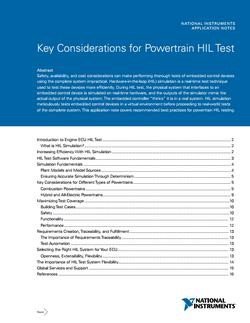Safety, availability, and cost considerations can make performing thorough tests of embedded control devices using the complete system impractical. Hardware-in-the-loop (HIL) simulation is a real-time test technique used to test these devices more efficiently. During HIL test, the physical system that interfaces to an embedded control device is simulated on real-time hardware, and the outputs of the simulator mimic the actual output of the physical system. The embedded controller “thinks” it is in a real system. HIL simulation meticulously tests embedded control devices in a virtual environment before proceeding to real-world tests of the complete system. This application note covers recommended best practices for powertrain HIL testing.
In this guide, learn about the tools and insight you need to build an effective HIL tester that will ensure you can achieve maximum test coverage and future proof your system against future technology requirements.
